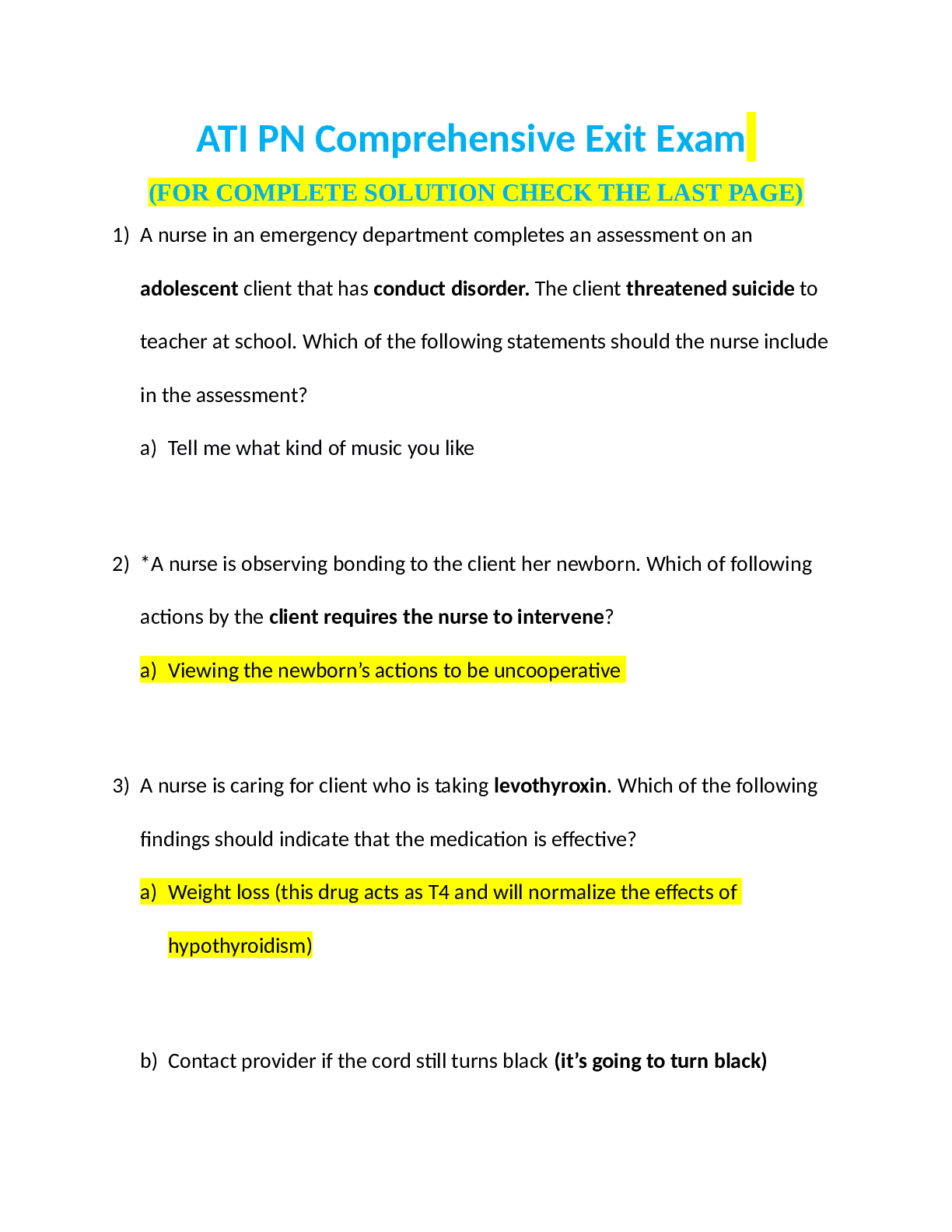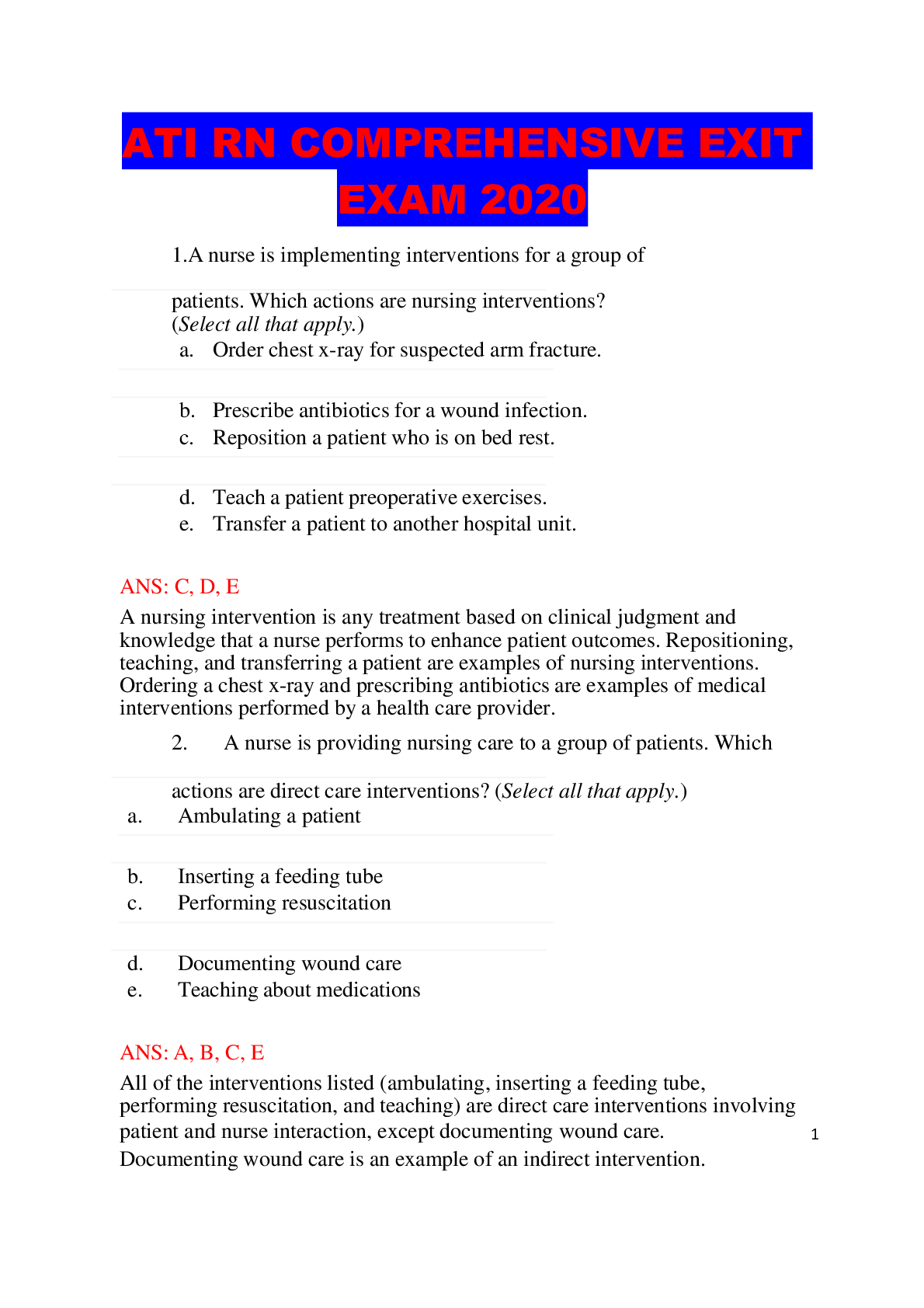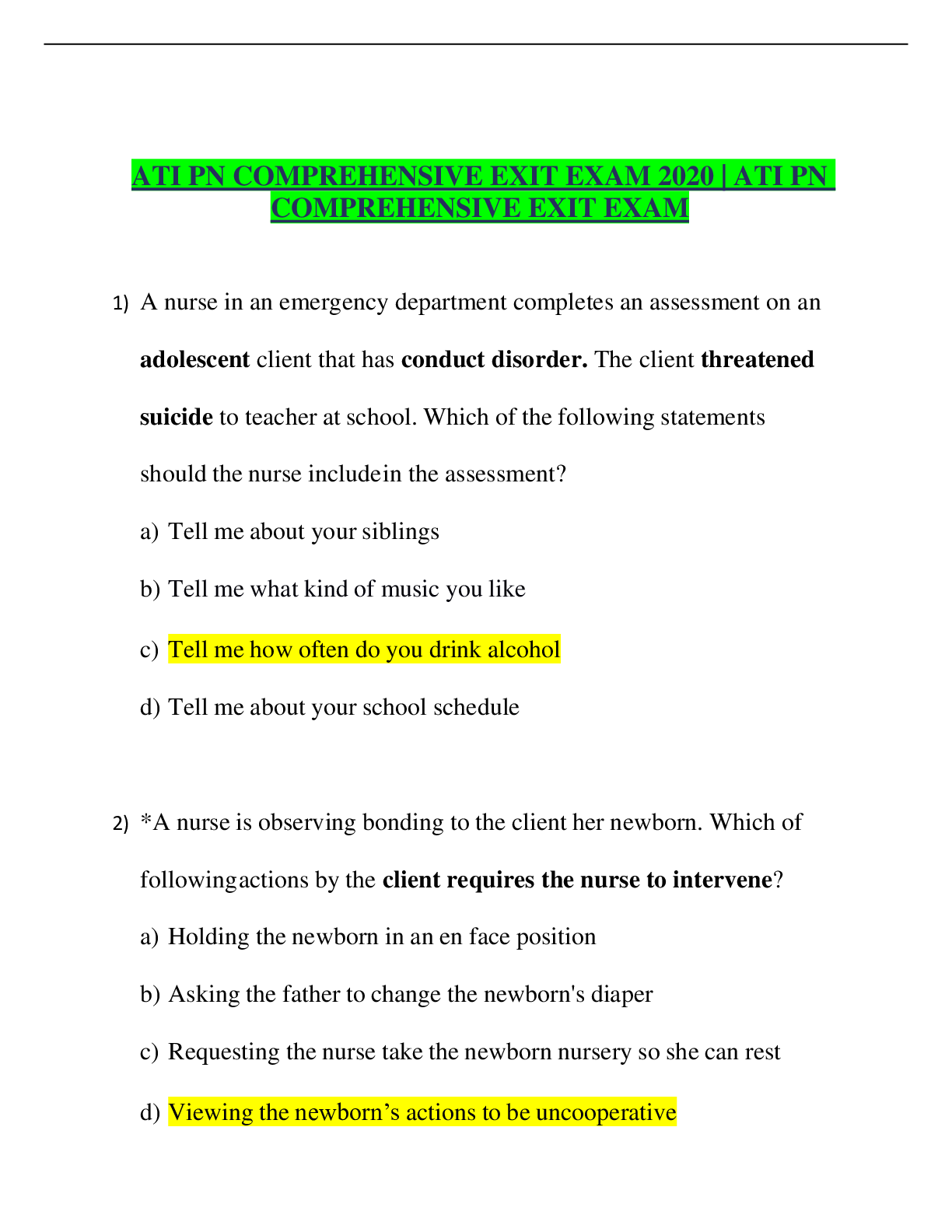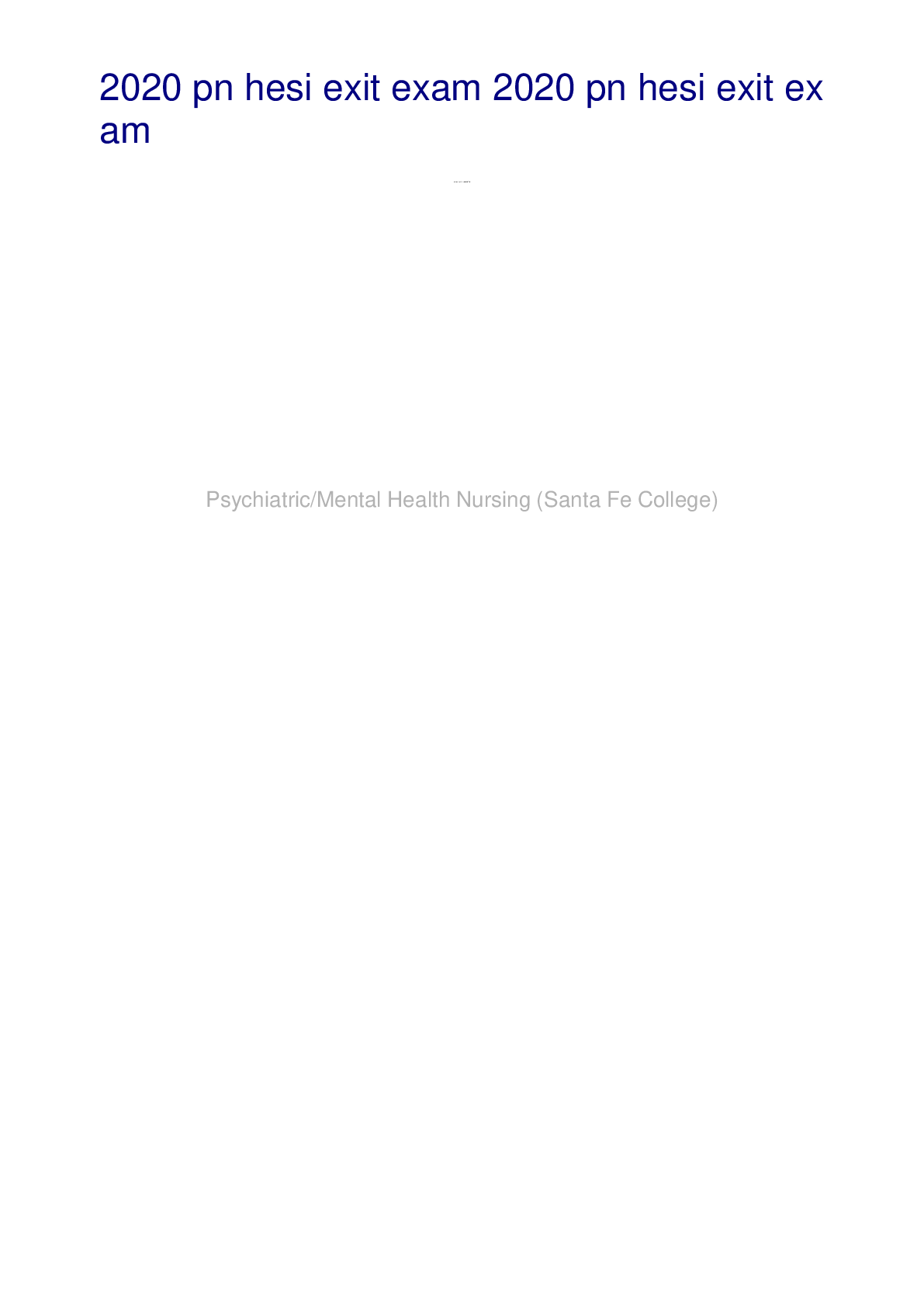RNSG 1137 EXIT EXAM 2020 – Tarrant College | RNSG1137 EXIT EXAM 2020
Document Content and Description Below
RNSG 1137 EXIT EXAM 2020 – Tarrant College 560+ pages of Questions with answers 1. Following discharge teaching, a male client with duodenal ulcer tells the nurse the he will drink plenty of dairy... products, such as milk, to help coat and protect his ulcer. What is the best follow-up action by the nurse? • Review with the client the need to avoid foods that are rich in milk and cream 2. A male client with hypertension, who received new antihypertensive prescriptions at his last visit returns to the clinic two weeks later to evaluate his blood pressure (BP). His BP is 158/106 and he admits that he has not been taking the prescribed medication because the drugs make him “feel bad”. In explaining the need for hypertension control, the nurse should stress that an elevated BP places the client at risk for which pathophysiological condition? • Stroke secondary to hemorrhage 3. The nurse observes an unlicensed assistive personnel (UAP) positioning a newly admitted client who has a seizure disorder. The client is supine and the UAP is placing soft pillows along the side rails. What action should the nurse implement? • Instruct the UAP to obtain soft blankets to secure to the side rails instead of pillows. 4. An adolescent with major depressive disorder has been taking duloxetine (Cymbalta) for the past 12 days. Which assessment finding requires immediate follow-up? • Describes life without purpose 5. A 60-year-old female client with a positive family history of ovarian cancer has developed an abdominal mass and is being evaluated for possible ovarian cancer. Her Papanicolau (Pap) smear results are negative. What information should the nurse include in the client’s teaching plan? • Further evaluation involving surgery may be needed 6. A client who recently underwear a tracheostomy is being prepared for discharge to home. Which instructions is most important for the nurse to include in the discharge plan? • Teach tracheal suctioning techniques 7. In assessing an adult client with a partial rebreather mask, the nurse notes that the oxygen reservoir bag does not deflate completely during inspiration and the client’s respiratory rate is 14 breaths / minute. What action should the nurse implement? • Document the assessment data • Rational: reservoir bag should not deflate completely during inspiration and the client’s respiratory rate is within normal limits. 8. During shift report, the central electrocardiogram (EKG) monitoring system alarms. Which client alarm should the nurse investigate firs? • Respiratory apnea of 30 seconds 9. During a home visit, the nurse observed an elderly client with diabetes slip and fall. What action should the nurse take first? • Check the client for lacerations or fractures 10. At 0600 while admitting a woman for a schedule repeat cesarean section (C-Section), the client tells the nurse that she drank a cup a coffee at 0400 because she wanted to avoid getting a headache. Which action should the nurse take first? • Inform the anesthesia care provider 11. After placing a stethoscope as seen in the picture, the nurse auscultates S1 and S2 heart sounds. To determine if an S3 heart sound is present, what action should the nurse take first? • Listen with the bell at the same location 12. A 66-year-old woman is retiring and will no longer have a health insurance through her place of employment. Which agency should the client be referred to by the employee health nurse for health insurance needs? • Medicare 13. A client who is taking an oral dose of a tetracycline complains of gastrointestinal upset. What snack should the nurse instruct the client to take with the tetracycline? • Toasted wheat bread and jelly 14. Following a lumbar puncture, a client voices several complaints. What complaint indicated to the nurse that the client is experiencing a complication? • “I have a headache that gets worse when I sit up” • “I am having pain in my lower back when I move my legs” • “My throat hurts when I swallow” • “I feel sick to my stomach and am going to throw up” 15. An elderly client seems confused and reports the onset of nausea, dysuria, and urgency with incontinence. Which action should the nurse implement? • Obtain a clean catch mid-stream specimen 16. The nurse is assisting the mother of a child with phenylketonuria (PKU) to select foods that are in keeping with the child’s dietary restrictions. Which foods are contraindicated for this child? • Foods sweetened with aspartame 17. Before preparing a client for the first surgical case of the day, a part-time scrub nurse asks the circulating nurse if a 3 minute surgical hand scrub is adequate preparation for this client. Which response should the circulating nurse provide? • Direct the nurse to continue the surgical hand scrub for a 5 minute duration 18. Which breakfast selection indicates that the client understands the nurse’s instructions about the dietary management of osteoporosis? • Bagel with jelly and skim milk 19. The charge nurse of a critical care unit is informed at the beginning of the shift that less than the optimal number of registered nurses will be working that shift. In planning assignments, which client should receive the most care hours by a registered nurse (RN)? • An 82-year-old client with Alzheimer’s disease newly-fractures femur who has a Foley catheter and soft wrist restrains applied 20. A mother brings her 6-year-old child, who has just stepped on a rusty nail, to the pediatrician’s office. Upon inspection, the nurse notes that the nail went through the shoe and pierced the bottom of the child’s foot. Which action should the nurse implement first? • Cleanse the foot with soap and water and apply an antibiotic ointment • Provide teaching about the need for a tetanus booster within the next 72 hours. • have the mother check the child's temperature q4h for the next 24 hours • transfer the child to the emergency department to receive a gamma globulin injection 21. The mother of an adolescent tells the clinic nurse, “My son has athlete’s foot, I have been applying triple antibiotic ointment for two days, but there has been no improvement.” What instruction should the nurse provide? • Stop using the ointment and encourage complete drying of the feet and wearing clean socks. 22. A 26-year-old female client is admitted to the hospital for treatment of a simple goiter, and levothyroxine sodium (Synthroid) is prescribed. Which symptoms indicate to the nurse that the prescribed dosage is too high for this client? The client experiences • Bradycardia and constipation • Lethargy and lack of appetite • Muscle cramping and dry, flushed skin • Palpitations and shortness of breath 23. A client with a history of heart failure presents to the clinic with a nausea, vomiting, yellow vision and palpitations. Which finding is most important for the nurse to assess to the client? • Obtain a list of medications taken for cardiac history 24. The healthcare provider prescribes an IV solution of isoproterenol (Isuprel) 1 mg in 250 ml of D5W at 300 mcg/hour. The nurse should program the infusion pump to deliver how many ml/hour? (Enter numeric value only.) • 75 • Rationale: Convert mg to mcg and use the formula D/H x Q. 300 mcg/hour / 1,000 mcg x 250 ml = 3/1 x 25 = 75 ml/hour 25. The pathophysiological mechanism are responsible for ascites related to liver failure? (Select all that apply) • Fluid shifts from intravascular to interstitial area due to decreased serum protein • Increased hydrostatic pressure in portal circulation increases fluid shifts into abdomen • Increased circulating aldosterone levels that increase sodium and water retention 26. The nurse is auscultating a client’s heart sounds. Which description should the nurse use to document this sound? (Please listen to the audio first to select the option that applies) • Murmur • Rationale: A murmur is auscultated as a swishing sound that is associated with the blood turbulence created by the heart or valvular defect. 27. The healthcare provider prescribes celtazidime (Fortax) 35 mg every 8 hours IM for an infant. The 500 mg vial is labeled with the instruction to add 5.3 ml diluent to provide a concentration of 100 mg/ml. How many ml should the nurse administered for each dose? (Enter numeric value only. If rounding is required, round to the nearest tenth) • 0.4 • rationale: 35mg/100mg x 1 = 0.35 = 0.4 ml 28. The nurse notes that a client has been receiving hydromorphone (Dilaudid) every six hours for four days. What assessment is most important for the nurse to complete? • Auscultate the client's bowel sounds • Observe for edema around the ankles • Measure the client’s capillary glucose level • Count the apical and radial pulses simultaneously • Rationale: hydromorphone is a potent opioid analgesic that slows peristalsis and frequently causes constipation, so it is most important to Auscultate the client's bowel sounds 29. A female client is admitted with end stage pulmonary disease is alert, oriented, and complaining of shortness of breath. The client tells the nurse that she wants “no heroic measures” taken if she stops breathing, and she asks the nurse to document this in her medical record. What action should the nurse implement? • Ask the client to discuss “do not resuscitate” with her healthcare provider 30. A client is receiving a full strength continuous enteral tube feeding at 50 ml/hour and has developed diarrhea. The client has a new prescription to change the feeding to half strength. What intervention should the nurse implement? • Add equal amounts of water and feeding to a feeding bag and infuse at 50ml/hour 31. A female client reports that her hair is becoming coarse and breaking off, that the outer part of her eyebrows have disappeared, and that her eyes are all puffy. Which follow-up question is best for the nurse to ask? • Have you noticed any changes in your fingernails? • Rationale: The pattern of reported manifestations is suggestive of hypothyroidism 32. After a third hospitalization 6 months ago, a client is admitted to the hospital with ascites and malnutrition. The client is drowsy but responding to verbal stimuli and reports recently spitting up blood. What assessment finding warrants immediate intervention by the nurse? • Capillary refill of 8 seconds • bruises on arms and legs • round and tight abdomen • pitting edema in lower legs 33. After the nurse witnesses a preoperative client sign the surgical consent form, the nurse signs the form as a witness. What are the legal implications of the nurse’s signature on the client’s surgical consent form? (Select all that apply) • The client voluntarily grants permission for the procedure to be done • The client is competent to sign the consent without impairment of judgment • The client understands the risks and benefits associated with the procedure 34. Following surgery, a male client with antisocial personality disorder frequently requests that a specific nurse be assigned to his care and is belligerent when another nurse is assigned. What action should the charge nurse implement? • Advise the client that assignments are not based on clients requests 35. A client with cervical cancer is hospitalized for insertion of a sealed internal cervical radiation implant. While providing care, the nurse finds the radiation implant in the bed. What action should the nurse take? • Place the implant in a lead container using long-handled forceps 36. The client with which type of wound is most likely to need immediate intervention by the nurse? • Laceration • Abrasion • Contusion • Ulceration • Rationale: A laceration is a wound that is produced by the tearing of soft body tissue. This type of wound is often irregular and jagged. A laceration wound is often contaminated with bacteria and debris from whatever object caused the cut. 37. The nurse is planning care for a client admitted with a diagnosis of pheochromocytoma. Which intervention has the highest priority for inclusion in this client’s plan of care? • Monitor blood pressure frequently • Rationale: A pheochromocytoma is a rare, catecholamine-secreting tumor that may precipitate life-threatening hypertension. The tumor is malignant in 10% of cases but may be cured completely by surgical removal. Although pheochromocytoma has classically been associated with 3 syndromes—von Hippel-Lindau (VHL) syndrome, multiple endocrine neoplasia type 2 (MEN 2), and neurofibromatosis type 1 (NF1)—there are now 10 genes that have been identified as sites of mutations leading to pheochromocytoma. 38. When caring for a client who has acute respiratory distress syndrome (ARDS), the nurse elevates the head of the bed 30 degrees. What is the reason for this intervention? • To reduce abdominal pressure on the diaphragm • to promote retraction of the intercostal accessory muscle of respiration • to promote bronchodilation and effective airway clearance • to decrease pressure on the medullary center which stimulates breathing • Rationale: a semi-sitting position is the best position for matching ventilation and perfusion and for decreasing abdominal pressure on the diaphragm, so that the client can maximize breathing. - -- - - - - - - - - - - - - - - - - - - - - - - - - - - - - - - - - exact cause of Guillain-Barre syndrome is unknown, but it is often preceded by an infectious illness such as a respiratory infection or the stomach flu. There's no known cure for Guillain-Barre syndrome, but several treatments can ease symptoms and reduce the duration of the illness. Most people recover from Guillain-Barre syndrome, though some may experience lingering effects from it, such as weakness, numbness or fatigue. 119. Know which position for a pt that had bone marrow taken out. BM aspiration site: iliac crest. 120. A client admitted to the hospital is suspected of having meningitis. The nurse should plan to prepare the client for which diagnostic test? Lumbar puncture 121. The nurse is performing an intake interview at a prenatal clinic. Which planned activities described by the client who is at 6 weeks gestations will the nurse investigate first? Supervision of the renovation of an old house the family just purchased due to teratogen defect. 122. A client in acute renal failure has a serum potassium level of 6.3 mEq/L. What medication can the nurse expect the healthcare provider to prescribe? Kayexalate retention enema. 123. The nurse is administering oxygento a client with pulmonary edema when a family member asks the nurse why the client needs oxygen. Which pathophysiological mechanism should the nurse explain to his family member? Fluid collects in the chest cavity and keeps the lungs from expanding. 124. During shift report, the nurse learns that a postoperative client has atelectasis. What nursing diagnosis should the nurse expect to include in the clients plan of care? Impaired gas exchange. 125. Fibrocystic Breast = Answer = Caffeine- the disease is painful, lumpy breasts Some women feel that eating chocolate, drinking caffeine, or eating a high-fat diet can cause their symptoms, but there is no clear proof of this, worse right before the menstrual period. Treatment- acetaminophen or ibuprofen, Use heat or ice on the breast, wear a well-fitting bra 126. Triage - put in order: 1. wondering man, 2. woman w/blanket, 3. man holding baby, 4. parents looking for son. 127. A hospitalized client’s bronchoscopy specimen culture result indicates the presence of the Mycobacterium tuberculosis organism. Which intervention is most important for the nurse to implement? Put the client in a room with negative airflow system. 128. A client with gestational diabetes at 39-weeks gestation is in the second stage of labor. After delivery of the fetal head, the nurse recognizes that shoulder dystocia is occurring. What intervention should the nurse implement first? Assist the client to sharply flex her thighs up against the abdomen 129. While assessing a client with wrist restraints the nurse first slides two fingers under the restraints and then notes that the ties are secured to the side rail using a quick-release tie. What action should the nurse implement? Reposition the restraints ties, securing them to the bed frame 130. While reporting a client’s blood glucose results to the nurse the LPN states that, the glucometer was not calibrated prior to use because the report given by the night shift staff ran late. What action is most important for the nurse to perform? Advise the LPN of the implications involved by not calibrating the glucometer 131. Patient is on radioactive chemotherapy = have the nurse be in the pt room for 30min with cluster care (this was a hard one – just look up nursing care for pt on chemo) 132. Understand the reason for Z track method( it use for IM) – prevent leakage 133. A client from a nursing home is admitted with urinary sepsis and has a single-lumen, peripherally- inserted central catheter (PICC). Four medications are prescribed for 9:00 a.m.and the nurse is running behind schedule. Which medication should the nurse administer first : (Zosyn) over 30 minutes q8 hours. 134. During a family baseball game, an adult male is hot on the head with a bat, and he is suspected of sustaining an epidural bleed. What Is the most important information for the emergency center nurse to obtain form the client’s spouse, who witnessed his injury? “Was your husband knocked out by the blow” 135. An 86-year-old female client complains to the nurse that she does not like to eat as much as she used to because things taste differently to her now that she is older. The nurse’s response should be based on which fact? A loss of appetitie often occurs in older adults as a result of a decreased sense of smell. 136. A client with a compound fracture of the left ankle is being discharged with a below-the-knee cast. Before being discharged, the nurse should provide the client with what instructions? 137. A 9-month old child with diarrhea, vomiting and malaise= Ask the mother on the onset of symptoms 138. An infant who is jittery and I think it said crying, what should the nurse do firs t= Assess blood glucose. 139. A client in acute renal failure has serum potassium of 7.5mEq/L. based on this finding, the nurse should anticipate implementing which action? Administer a retention enema of Kayexalate 140. A pt with COPD who state that he is using is inhaler right, what should the nurse indicate the pt is not using the inhaler properly= Pt states that he only uses the inhaler when he is having respiratory distress 141. CPR for a pregnant lady= will give Heimlich w/ chest compression HESI HINT: At 20wks gestation & beyond, the gravid uterus should be shifted to the left by placing the women in a 15-30 degree angled, left lateral position or by using a wedge under her right side to tilt her to her left 142. Pyelonephritis symptoms - elevates temperature 143. The nurse observes tha a client has received 250 ml of 0.9% normal saline through the IV line in the last hour. The client is now tachypneic, and has a pulse rate of 120 beats/minute, with a pulse volume of +4. In addition to reporting the assessment findings to the healthcare provider, what action should the nurse implement? Decrease the saline keep-open rate. The nurse should decrease the rate of the IV solution to keep-open rate to avoid further fluid volume overload while awaiting a change in prescription from the healthcare provider. 144. On osteoporosis= weight bearing physical activity 145. Education about DM= to increase knowledge on the disease process and treatment 146. Cerebral palsy – prognosis neurological disorders that appear in infancy or early childhood and permanently affect body movement and muscle coordination. Cerebral palsy doesn’t always cause profound disabilities. While one child with severe cerebral palsy might be unable to walk and need extensive, lifelong care, another with mild cerebral palsy might be only slightly awkward and require no special assistance. Supportive treatments, medications, and surgery can help many individuals improve their motor skills and ability to communicate-symptoms, paraplegia, quadriplegia, hemiplegia, seizure, retardation, learning issues, behavior, bladder bowel bone issues 147. A 60yrs Pt with advance prostate cancer which response indicate that he accept his prognosis or illness = Pt admits that he has support of family & friends – use your judgment on this one) Community primary prevention 148. The risk for metabolic shock syndrome – Toxic Shock Syndrome 149. Side effects of aspirin- (Reye syndrome in kids) Overdose may happen if your kidneys do not work correctly or when you are dehydrated. Signs include ringing in the ears, deafness, hyperactivity, dizziness,drowsiness, seizures, coma, Treatment-fluids, activated charcoal, laxative, IV of potassium, sodium bicarb 150. The nurse is reviewing the medical history of a client who is scheduled for a parathyroidectomy. Which disorder in the client’s history is most likely to be impacted by the surgery? Osteoporosis. 151. A female client reports that she drank ¾ of a liter of a solution to cleanse her intestines for a colonoscopy. How many ml of fluid intake should the nurse document? (Enter numeric value only. If rounding is required, round to the nearest whole number.) 152. First convert the liter to ml: 1L × 1000 = 1000ml. Next multiply 1000 by ¾ = 750 ml. 152. The nurse is instructing a client who is newly diagnosed with Addison's disease. Which of the following should the nurse include when discussing the manifestations of this disease with the client? Hyperkalemia, hyponatremia, and hypoglycaemia. 153. A client is admitted to the nursing unit with a possible bowel obstruction. The nurse osculates high-pitched bowel sounds in the upper quadrants of the client’s abdomen. What is the significance of this finding? Provides data about the location of the obstruction. High-pitched bowels sounds may be ausculated above the bowel obstruction early in the obstructive process as peristalsis initially increases, and may help determine the location of the obstruction. 154. Inserting NG tube in client that becomes cyanotic- withdraw NG tube (1 st action) 155. Client in labor, you call the provider and he has slurred words, loud noise in background, and seems intoxicated- you should contact the healthcare provider’s associate, not the medical director 156. After a sexual assault, the nurse collects evidence for 6hrs then should do what- maintain possession of the evidence collection kit at all times 157. A 93 year-old male client is brought to the emergency room by a group of fraternity brothers after a hazing event at the university. The client arrives with a blood alcohol level (BAL) of 3.8 and a Glasgow Coma Scale of 3. Which action should the nurse implement first? Initiate IV access using Lactated Ringer’s solution 1000ml with thiamine 100mg. Hydrating the client and providing thiamine (Vitamin B) to prevent neurological insult from ethanol toxicity are the highest priority interventions. 158. The nurse is preparing to administer vancomycin (Vancocin) 500mg in 200 ml of D6W, and based on the manufacturer’s recommendation, the nurse plans to administer the dosage over 90 minutes. The secondary infusion pump should be set to administer how many ml/hour? (Enter numeric value only. If rounding is required, round to the nearest whole number.) 133. 200ml of the antibiotic is to infuse over 90minutes. 200ml divided by 90minutes/hour equals 133.33=133ml/hour. 159. BNP prescribed diuretic 500 indicates HF 160. Pancreatitis maintain IV: 125 ml/hr Help [Show More]
Last updated: 2 years ago
Preview 1 out of 544 pages

Buy this document to get the full access instantly
Instant Download Access after purchase
Buy NowInstant download
We Accept:

Reviews( 0 )
$24.00
Can't find what you want? Try our AI powered Search
Document information
Connected school, study & course
About the document
Uploaded On
Nov 08, 2020
Number of pages
544
Written in
Additional information
This document has been written for:
Uploaded
Nov 08, 2020
Downloads
0
Views
109








 – University of the People.png)
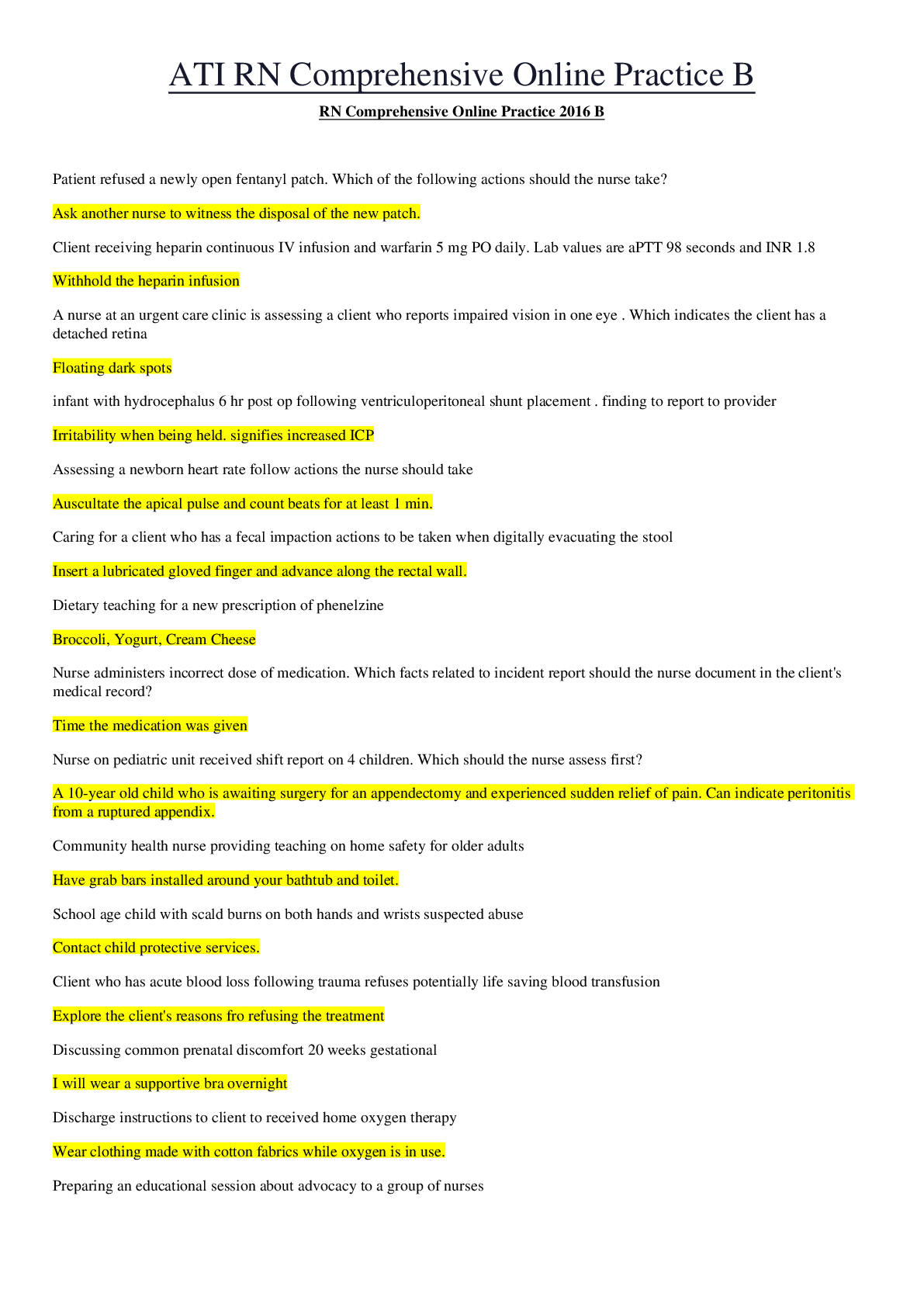



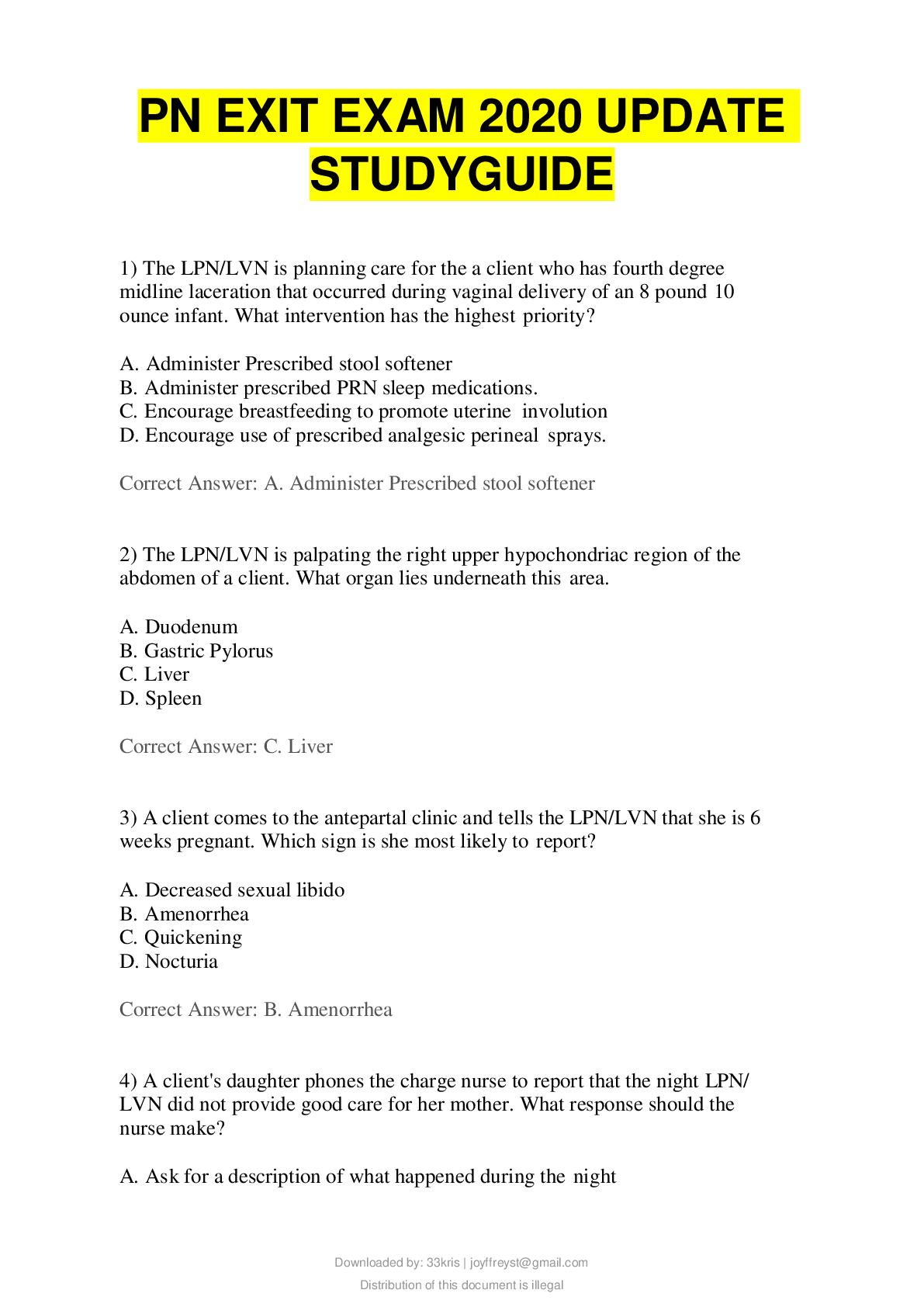
.png)
